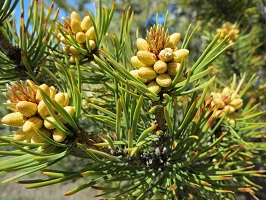
This piece is designed to make you aware of the many benefits of pine pollen. That’s right, it’s a superfood that can be put to many uses, and we’re actually coming up on the time that it can be harvested in the wild. Raw pine pollen is good for a lot of different things, especially exercise and physical training. Let’s outline some of the qualities of it and cite some references for your perusal.
Pine Pollen is a Powerhouse of Nutrients
Pine pollen is, technically, the male “sperm” cells of the pine tree, and is analogous to a plant-formulated testosterone. Don’t smirk, ladies: in this form, it is very beneficial for you as well. Studies prove that low testosterone levels in both genders (yes, women also have a minute quantity of it in their bodies) cause cholesterol levels (the “bad” form of it) to increase. Low levels also cause losses of bone and tissue that translate into aging prematurely, and also significant weight gain (fat), sexual problems, and cardiovascular problems.
With men, in particular, low testosterone levels lead to a higher probability of cancer. Pine pollen can fight all of these with its components of Phyto-androgens, which are the sexual hormones found in human beings but produced in plants. This is really neat stuff because the pine pollen gives you androstenedione, testosterone, DHEA (dehydroepiandrosterone), and androsterone. Sift through the archives and you’ll find some articles I wrote on DHEA and testosterone that go into detail.
Some of the ailments that raw pine pollen can fight off are high cholesterol, chronic fatigue, and diabetes. These conditions have been dramatically improved by the regular addition of pine pollen to the diet. Although these Phyto-androgens are almost identical to the ones produced by the human body, there is still a slight difference, and this is beneficial: the difference enables the body to continue producing its normal levels of the androgens without being affected by the addition of the pine pollen.
It can be taken in the form of powder or tincture, and with either case mixed with a beverage. The tincture is the more easily-consumed out of the two forms. Here are a few websites to help you in your quest for further information:
http://www.rawforestfoods.com/questions.html
http://rawfoodhealthwatch.com/pine-pollen/
http://www.righthealth.com/topic/Pine_Pollen…
- Alanine 17mg
- Arginine 30mg
- Aspartic acid 33mg
- Cysteine 3mg
- Glutamic acid 47mg
- Glycine 21mg
- Histidine 6mg
- Isoleucine 16mg
- Leucine 25mg
- Lysine 24mg
- Phenylalanine 17mg
- Proline 26mg
- Serine 16mg
- Threonine 15mg
- Tryptophan 4mg
- Tyrosine 11mg
- Valine 19mg
The recommended amount to consume is ½ to 1 tsp per day. Pine pollen is also chock full of vitamins and minerals, as well as acids and a ton of substances that normally we buy in bunches, such as resveratrol and MSM. These substances are all right there in the pine pollen. I have seen many places to order it online, and your finer health food stores will (at the bare minimum) be able to order it for you. As with all things, consult with your physician prior to using any of the information or materials mentioned in this article. JJ out!
Jeremiah Johnson is the Nom de plume of a retired Green Beret of the United States Army Special Forces (Airborne). Mr. Johnson was a Special Forces Medic, EMT and ACLS-certified, with comprehensive training in wilderness survival, rescue, and patient-extraction. He is a Certified Master Herbalist and a graduate of the Global College of Natural Medicine of Santa Ana, CA. A graduate of the U.S. Army’s survival course of SERE school (Survival Evasion Resistance Escape), Mr. Johnson also successfully completed the Montana Master Food Preserver Course for home-canning, smoking, and dehydrating foods.
Mr. Johnson dries and tinctures a wide variety of medicinal herbs taken by wild crafting and cultivation, in addition to preserving and canning his own food. An expert in land navigation, survival, mountaineering, and parachuting as trained by the United States Army, Mr. Johnson is an ardent advocate for preparedness, self-sufficiency, and long-term disaster sustainability for families. He and his wife survived Hurricane Katrina and its aftermath. Cross-trained as a Special Forces Engineer, he is an expert in supply, logistics, transport, and long-term storage of perishable materials, having incorporated many of these techniques plus some unique innovations in his own homestead.
Mr. Johnson brings practical, tested experience firmly rooted in formal education to his writings and to our team. He and his wife live in a cabin in the mountains of Western Montana with their three cats.
This information has been made available by Ready Nutrition